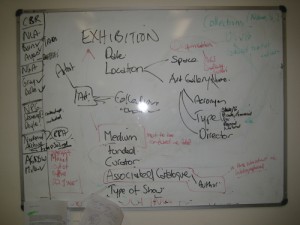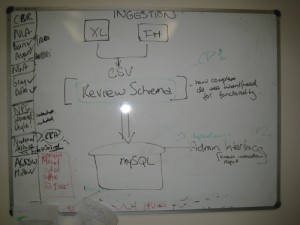This week Olivia and I have been focusing on the schema changes we need to implement in order to capture additional information on Exhibitions. We have been analysing Jonathan Holmes’ wonderful Art@Base exhibitions database, which, as well as providing much needed content, has provided a very useful model for an expanded exhibitions field structure.
We have also been using some initial User Scenarios (developed in my early scoping of the project) and actual CI research projects to develop benchmarks. We do this by mining your research proposals to elicit the series of queries that would satisfy the informational demands of your project. The diagram below represents the beginning of mapping such benchmarks. The project that we were scribbling about below has 6 major types of queries for the DAAO, i.e. report relationship between curators and exhibitions, or report relationship between exhibitions with X heritage values. At the moment the DAAO can only respond to 3 of the 6 type queries and it could not display the relationships between variables in a comprehensible way. Thus at the end of the project, we would expect the DAAO to answer all six questions and display results in meaningful and variable ways. So the more information we get about your research proposals, the better we can design how the new data we are incorporating can be organised.
We have also started thinking about the processes of ingestion as new high quality research data appear out of dark to find a new home in the DAAO. In order for data to be ingested, we have to match the tables of different databases. Simply put, we need to lay out all the tables side by side in an excel document, compare the field structures and their naming conventions and then co-ordinate and systematise a matching of their structures. The diagram below came out of discussion I had with David Turnbull (Manager, Web and Innovation, UNSW), where we were talking about the process of an an ingestion module and how it interacts with the critical path of our project.
David is on our Technical Steering Committee, and he is one of many people around here that always has some time to explain and clarify technical issues. Another is the patient and sensible Laszlo Gercsov, UNSW Digital Library’s Systems Architect. We are very lucky to have such clever and helpful people around.
The word of this week is LEGACY, which sounds ok until you match it with the word ISSUES. Another of the helpful clever people around here at UNSW is CSE’s Daniel Woo. I’ve known Daniel’s work for years, but he has just finished managing a database project, and his calm words had the hard edge of fresh experience behind them. LEGACY ISSUES, he said. Ah yes. Migration path. On the list for next week.


